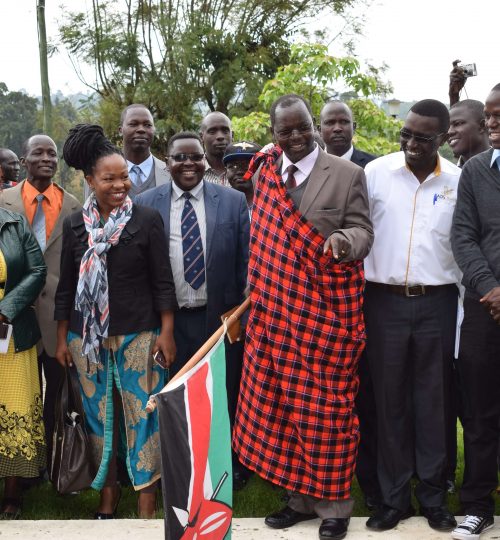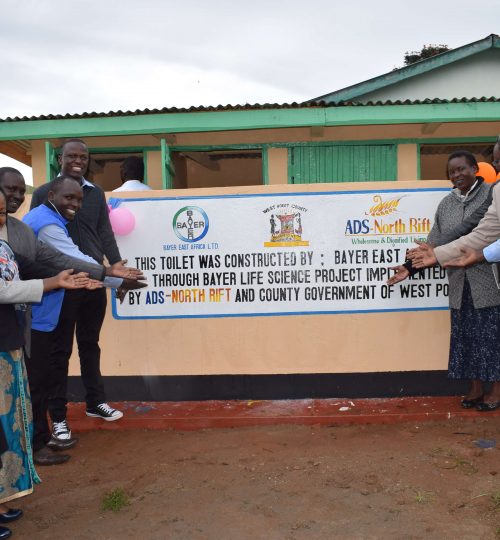BAYER
Crop, Livestock and Health Development - Project Period (2017-2018)

Project Overview
Anglican Development Services North Rift Region, in partnership with the County Government of West Pokot with support from BAYER East Africa, implemented the Crop, Livestock, and Health Development Project in West Pokot County. The project aimed at improving income and livelihood diversification for 8,000 people living in poverty and exclusion in West Pokot County through bulking of farm produce, livestock farming, and health and sanitation.
BACKGROUND INFORMATION
West Pokot County is one of the 6 Counties ADS-NR engages in facilitating community development processes. It lies in the Rift Valley province of Kenya. It borders Turkana County to the North, Baringo to the East, Elgeyo Marakwet, Trans Nzoia to the South, and the Republic of Uganda to the West. The residents of West Pokot are herders and also practice mixed farming.
Based on the available statistics West Pokot is rated among the poor Counties of Kenya mainly because of scarce resources and opportunities. West Pokot County has a poverty index of 68.7% according to the West Pokot 2013 CIDP county fact sheet. This contributes to the national poverty index by 2.1%. The main source of household income in West Pokot is from Agriculture and livestock which contributes 84% of the county income while 69% of the total population faces food insecurity (CIDP 2013).



Goals & Objectives
OBJECTIVE 1: CROPS DEVELOPMENT
To promote livelihood diversification for 8,000 people living in poverty and exclusion in West Pokot County especially smallholder farmers through the availability of clean, high-quality, and improved planting materials.
RESULTS
- 2,300 households representing over 13,800 people diversified their food sources thus improving their nutritional intake. Reduction of hunger months by 30%.
- Enhanced self-esteem and confidence among the household members in farming practices
- The establishment of 7 demonstration plots saw replication of the farming techniques learned.
- Increased income where household members are able to sell excess produce from the demo plot and bulking sites thus enhancing the availability of disposable income.
- 300 households received free samples of potato and cassava planting materials for bulking at their farms. Clean planting/propagation materials are now available within reach.
- 1,200 households benefited directly from the Irish potatoes planting materials and bananas hardened from the shade nets. Through bulking, clean planting materials have been increased from 800kg to 2400kg.
- Increased capacity of farmers to engage in modern farming through 20 trained Trainer of Trainers (TOTs). Each TOT is attached to save a community unit.
- Enhanced engagement of the relevant County departments will lead to the sustained provision of technical expertise to the farmers.
OBJECTIVE 2: LIVESTOCK DEVELOPMENT
To Improve household income for livestock keepers and increase awareness on improved breeding stock
RESULTS
- Support in terms of livestock production and veterinary tools which improved service delivery and enhanced livestock production
- Community members benefited from the breeding centers where the improved Galla goats, Dorper sheep, and Sahiwal cows were being used to improve their local breeds.
- The fingerlings from the fish ponds improved fish farming by the community members which was expected to greatly enhance their livelihoods.
- Enhanced involvement of the relevant County departments which was expected to equip the livestock farmers with skills in livestock breeding and management.
- Enhance the capacity of Field extension officers to deliver services
OBJECTIVE 3: HEALTH COMPONENT
To Improve household uptake of health and sanitation information on good practice to reduce effects of FGM on girls and women as well as reduce diseases associated with hygiene and sanitation.
RESULTS
- Enhanced awareness of the negative effects of harmful cultural practices like FGM and early marriages.
- Increased awareness and access to medical services by community members.
- The academic performance of learners from the 5 schools improved due to improved sanitation facilities and a general learning environment.
- The establishment of an ablution block at St. Francis School for the visually impaired also raised awareness of the needs of the disadvantaged in the society and many stakeholders promised to provide the necessary support.
- One classroom constructed in Cheptany – Kodich war
- Community water project rehabilitated to serve 200 households
- Improved collaboration with the county and other stakeholders will ensure that community members adopt good cultural practices
- Hygiene sanitation practices as well as access health services.
- Enhanced hygiene and sanitation practices among community members.
ADS - North Rift Projects
All our projects are undertaken based on the greatest need for poverty alleviation as informed by socio-economic indicators, always with the disposition of love and respect for God and His people.
Feedback?
Do you have a question or feedback about this project? Talk to us today.
